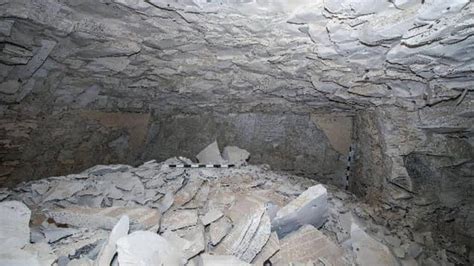
Archaeologists in Egypt have unearthed three ancient tombs dating back approximately 3,500 years to the New Kingdom period, a discovery shedding light on the burial practices and societal structures of the time. The tombs, found near the city of Aswan, likely belonged to high-ranking officials and offer a glimpse into a significant era of Egyptian history.
The Egyptian Ministry of Tourism and Antiquities announced the find, detailing that the Italian Archaeological Mission, led by Patrizia Piacentini, from the University of Milan, conducted the excavations. The discovery site is located on the West Bank of Aswan, near the Aga Khan Mausoleum, an area known for its historical significance but not as extensively explored as other regions in Egypt. “The mission has been working in the Aswan area since 2018 with the aim of finding the still untouched tombs of the West Bank,” the ministry stated.
The tombs are believed to date to between 1550 B.C. and 1070 B.C., the period of the New Kingdom when Egypt experienced considerable prosperity, military expansion, and artistic flourishing. This era saw the reigns of famous pharaohs such as Hatshepsut, Akhenaten, Tutankhamun, and Ramses II, each of whom left indelible marks on Egyptian history. The location of the tombs suggests they were intended for individuals of considerable status, potentially governors, high priests, or other influential figures within the Aswan region.
“One of these tombs is of particular interest because it contains remarkable depictions,” said Piacentini. “The scenes on the walls show details of funerary rituals and offer insight into the beliefs and practices of the time.” The intricate artwork inside this tomb provides invaluable data for understanding ancient Egyptian religious beliefs and funerary customs, including depictions of offerings to the deceased and their journey into the afterlife.
Preliminary analysis of the tombs indicates that they were constructed with mud-brick and stone, characteristic of the era’s architectural style. Although the tombs have suffered some damage over the millennia due to weathering and looting, the surviving elements offer crucial clues about their original appearance and function. Fragments of pottery, sarcophagi, and other funerary objects were also found inside the tombs, which are currently being analyzed to determine their age, origin, and significance.
The discovery underscores the importance of ongoing archaeological research in Egypt. Despite centuries of exploration, many areas still hold untold secrets about the country’s rich history. The New Kingdom period, in particular, is a focus for archaeologists and historians, given its pivotal role in shaping Egyptian culture and its impact on the broader ancient world.
“Discoveries like these not only add to our knowledge of ancient Egypt but also help to promote tourism and cultural preservation,” said a representative of the Ministry of Tourism and Antiquities. The Egyptian government has been actively supporting archaeological projects across the country as part of its broader strategy to boost tourism and showcase Egypt’s heritage to the world.
The Italian Archaeological Mission continues to excavate and analyze the tombs, hoping to uncover further details about the individuals who were buried there and their place in ancient Egyptian society. The findings will contribute significantly to a deeper understanding of the New Kingdom period and its lasting legacy.
In-Depth Analysis and Context
The discovery of the three New Kingdom tombs near Aswan presents a significant opportunity for researchers to gain deeper insights into the political, social, and religious landscape of ancient Egypt. The New Kingdom, also referred to as the Egyptian Empire, represents a golden age in Egyptian history, marked by powerful pharaohs, extensive building projects, and military campaigns that extended Egypt’s influence across the Near East.
Historical Significance of the New Kingdom:
The New Kingdom (c. 1550-1070 B.C.) followed the Second Intermediate Period, a time of political instability and foreign rule. The pharaohs of the New Kingdom, particularly those of the 18th, 19th, and 20th dynasties, reasserted Egyptian authority, expanded the empire, and initiated massive construction projects. Some key figures include:
-
Hatshepsut (c. 1479-1458 B.C.): A female pharaoh who focused on trade and internal development rather than military conquest, commissioning numerous temples and monuments.
-
Akhenaten (c. 1353-1336 B.C.): A controversial ruler who introduced monotheism by worshipping the sun god Aten, causing significant religious and political upheaval.
-
Tutankhamun (c. 1332-1323 B.C.): Best known for his intact tomb discovered by Howard Carter in 1922, he reversed Akhenaten’s religious reforms and restored traditional religious practices.
-
Ramses II (c. 1279-1213 B.C.): Known for his long reign and extensive building projects, including the colossal temples at Abu Simbel. He also engaged in numerous military campaigns and signed what is considered the first peace treaty with the Hittites.
The New Kingdom was a period of significant artistic and cultural achievements, with advancements in architecture, sculpture, painting, and literature. The Valley of the Kings, located near Thebes (modern-day Luxor), became the primary burial site for pharaohs and high-ranking officials, reflecting the importance placed on the afterlife and the preservation of the body for eternity.
Aswan’s Strategic Importance:
Aswan, situated in southern Egypt, held strategic and economic importance throughout ancient Egyptian history. As the gateway to Nubia, it served as a vital trading center and a source of valuable resources, including gold, granite, and exotic goods. The Aswan quarries provided the stone used in many of Egypt’s most iconic monuments, including the pyramids and temples.
During the New Kingdom, Aswan continued to be an important administrative and military center. The region was governed by powerful officials who controlled trade routes and oversaw the extraction of resources. The discovery of the tombs near Aswan highlights the presence of a wealthy and influential elite in the area, reflecting the region’s significance within the broader Egyptian empire.
Funerary Practices and Beliefs:
The ancient Egyptians had elaborate beliefs about the afterlife, which profoundly influenced their funerary practices. They believed that after death, the soul (Ba) and the life force (Ka) continued to exist and required sustenance and protection. Tombs were designed to provide a home for the deceased in the afterlife and were filled with provisions, including food, clothing, furniture, and weapons.
Funerary rituals played a crucial role in ensuring the deceased’s successful transition to the afterlife. These rituals included mummification, which preserved the body, and the performance of religious ceremonies to ensure the soul’s safe passage. The Book of the Dead, a collection of spells and prayers, was often placed in the tomb to guide the deceased through the underworld and help them overcome the challenges they would face.
The artwork found in the tombs provides valuable insights into these funerary practices and beliefs. Depictions of offerings, religious ceremonies, and scenes from the afterlife offer a glimpse into the complex worldview of the ancient Egyptians and their hopes for eternity.
The Italian Archaeological Mission’s Work:
The Italian Archaeological Mission, led by Patrizia Piacentini, has been working in the Aswan area since 2018, focusing on uncovering previously unexplored tombs on the West Bank. Their meticulous work involves excavating the tombs, documenting the architecture and artwork, and analyzing the artifacts found within.
The mission employs a multidisciplinary approach, combining archaeological expertise with scientific techniques to gain a comprehensive understanding of the site. They collaborate with specialists in various fields, including Egyptology, anthropology, and conservation, to ensure that the finds are properly documented and preserved.
The discovery of the three New Kingdom tombs is a testament to the mission’s dedication and expertise. Their ongoing work promises to reveal further insights into the history and culture of ancient Egypt and to contribute to a greater appreciation of Egypt’s rich heritage.
Potential Significance of the Discovery:
The discovery of the three New Kingdom tombs has the potential to significantly contribute to our understanding of ancient Egypt in several ways:
-
Social Structure: The tombs’ size, location, and contents can provide information about the social hierarchy and the roles of high-ranking officials in the Aswan region during the New Kingdom.
-
Religious Beliefs: The artwork and inscriptions found within the tombs can offer insights into the religious beliefs and funerary practices of the time, shedding light on the ancient Egyptians’ understanding of the afterlife.
-
Economic Activities: The artifacts found in the tombs, such as pottery, jewelry, and tools, can provide clues about the economic activities and trade networks of the Aswan region during the New Kingdom.
-
Artistic Styles: The architectural features and artistic styles of the tombs can help to trace the development of Egyptian art and architecture during the New Kingdom and to identify regional variations.
-
Daily Life: The objects found in the tombs can offer insights into the daily lives of the individuals who were buried there, including their clothing, diet, and personal possessions.
Challenges and Future Research:
Despite the potential significance of the discovery, the researchers face several challenges in their work. The tombs have suffered damage over the millennia due to weathering, looting, and human activity. The fragile nature of the artifacts requires careful handling and conservation.
The Italian Archaeological Mission plans to continue excavating and analyzing the tombs in the coming years. They hope to uncover further details about the individuals who were buried there and to reconstruct the original appearance of the tombs. They also plan to conduct scientific analyses of the artifacts to determine their age, origin, and composition.
The findings will be published in academic journals and presented at conferences, contributing to the ongoing study of ancient Egypt and promoting a greater understanding of its rich history and culture.
Preservation and Tourism:
The discovery of the three New Kingdom tombs also has implications for cultural preservation and tourism. The Egyptian government is actively working to protect and preserve its archaeological sites, recognizing their importance as cultural heritage and their potential to attract tourists.
The Ministry of Tourism and Antiquities is supporting archaeological projects across the country and is investing in infrastructure to improve access to historical sites. The discovery of the tombs near Aswan is expected to attract more tourists to the region, boosting the local economy and raising awareness of Egypt’s rich history.
However, the increased tourism also poses challenges for preservation. Measures must be taken to protect the tombs from damage caused by visitors and to ensure that the surrounding environment is not harmed. Sustainable tourism practices are essential to balance the economic benefits of tourism with the need to preserve Egypt’s cultural heritage for future generations.
Conclusion:
The unearthing of three 3,500-year-old tombs near Aswan is a noteworthy archaeological find that promises to enrich our understanding of ancient Egypt’s New Kingdom era. The ongoing work of the Italian Archaeological Mission, combined with the Egyptian government’s commitment to cultural preservation and sustainable tourism, holds the potential to unlock further secrets of the past and to share Egypt’s rich heritage with the world. The discovery serves as a reminder of the enduring allure of ancient Egypt and its profound impact on human history.
Frequently Asked Questions (FAQ)
1. Where were the tombs discovered, and what is the significance of this location?
The tombs were discovered on the West Bank of Aswan, near the Aga Khan Mausoleum, in Egypt. This location is significant because Aswan served as a crucial administrative and economic center during the New Kingdom, acting as a gateway to Nubia and a source of valuable resources. The presence of these tombs suggests that high-ranking officials or influential figures resided in this area, highlighting Aswan’s importance within the broader Egyptian empire.
2. To what period do these tombs date, and what makes this period important in Egyptian history?
The tombs date back to the New Kingdom period, specifically between 1550 B.C. and 1070 B.C. This period, also known as the Egyptian Empire, is considered a golden age in Egyptian history due to its prosperity, military expansion, and artistic achievements. It was a time when pharaohs like Hatshepsut, Akhenaten, Tutankhamun, and Ramses II ruled, leaving a lasting impact on Egyptian culture and its influence on the ancient world.
3. What kind of information can be gleaned from the artwork and artifacts found inside the tombs?
The artwork and artifacts found inside the tombs can provide valuable insights into the funerary practices, religious beliefs, and daily life of the ancient Egyptians during the New Kingdom. The artwork, such as depictions of offerings and religious ceremonies, can shed light on their understanding of the afterlife. Artifacts like pottery, jewelry, and tools can offer clues about their economic activities, trade networks, social structure, and artistic styles of the time.
4. Who is leading the archaeological mission, and what approach are they taking in their work?
The Italian Archaeological Mission, led by Patrizia Piacentini from the University of Milan, is conducting the excavations. The mission employs a multidisciplinary approach, combining archaeological expertise with scientific techniques to gain a comprehensive understanding of the site. They collaborate with specialists in Egyptology, anthropology, and conservation to ensure the proper documentation and preservation of the finds.
5. What are the challenges involved in excavating and preserving these ancient tombs, and what are the plans for future research and preservation efforts?
The tombs have suffered damage over millennia due to weathering, looting, and human activity, posing challenges for excavation and preservation. The fragile nature of the artifacts requires careful handling and conservation. The Italian Archaeological Mission plans to continue excavating and analyzing the tombs, hoping to uncover further details and reconstruct their original appearance. They also plan to conduct scientific analyses of the artifacts to determine their age, origin, and composition. Preservation efforts include protecting the tombs from further damage and implementing sustainable tourism practices to balance economic benefits with the need to preserve Egypt’s cultural heritage for future generations.









